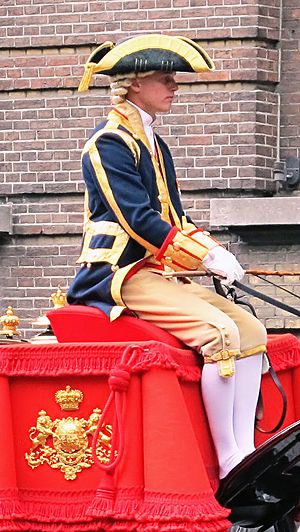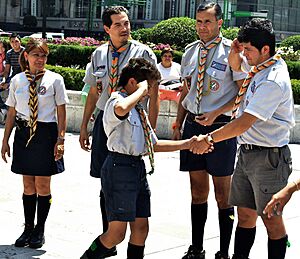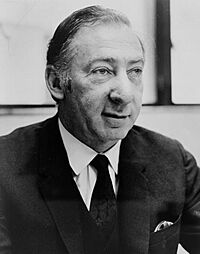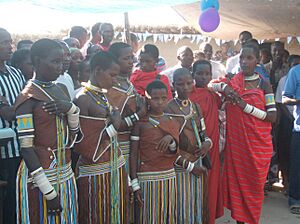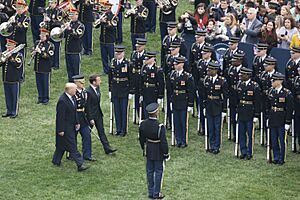Ceremony facts for kids
A ceremony is a special event that follows a set of traditions or rules. It usually includes different artistic parts like music, speeches, or symbolic actions. Ceremonies are performed for important occasions. The word "ceremony" might come from the ancient Etruscan language, through the Latin word caerimonia.
Contents
Religious and Non-Religious Ceremonies
Ceremonies can be either religious or non-religious (also called civil or secular). Experts like Dally Messenger and Alain de Botton say that in many Western countries, the ideas and values in both types of ceremonies are quite similar. The main difference is whether they involve beliefs about a god or a "supernatural" (beyond nature) element.
For example, in some religions, people believe that a god gives an extra benefit during a ceremony. Roman Catholics, for instance, believe that during their Mass ceremony, God becomes truly present.
Both religious and non-religious ceremonies have strong effects on people's feelings, how they interact with others, and their culture. They help people feel connected and understand important moments. The music, words, and actions used in ceremonies can be very different, but they all aim to create a meaningful experience.
Old Traditions Still Used Today
Many ceremonies, especially those for big life events like weddings, have very old traditions. Some parts of modern wedding ceremonies, for example, come from ancient Roman and Greek times, even before Christianity. These traditions have continued for hundreds of years. For instance, the idea of having a best man and bridesmaids, walking in a procession, signing a contract, exchanging rings, and having a wedding cake all come from ancient Roman wedding practices.
Learning from Religious Traditions
Some thinkers, like Alain de Botton, believe that even people who don't follow a religion (atheists) can learn from the good parts of religious traditions. He thinks that non-religious people can use the beautiful art, symbols, and ideas that religions have inspired. He also argues that the non-religious world can learn how important community and lasting traditions are. Dally Messenger agrees, noting that non-religious ceremony leaders in Australia have been successful by using these ideas since 1973.
History of Non-Religious Ceremonies
A big step forward for non-religious ceremonies in Western countries came from an Australian leader named Lionel Murphy. In 1973, Australia started a program where specially chosen people, called civil celebrants, were given the job of creating meaningful and respectful ceremonies for people who didn't want a church ceremony. This idea has since been adopted by countries like New Zealand, Canada, the United Kingdom, and some parts of the United States.
Why Non-Religious Ceremonies Are Important
Dally Messenger says that non-religious ceremonies act like "roadmaps" that guide people toward a good, ethical, and respectful life. Ceremonies help people feel stable, understand who they are, and feel good about themselves. Lionel Murphy believed that personal, heartfelt ceremonies were key to a polite, stable, and happy society. He shared this idea with mythologist Joseph Campbell, who thought that how civilized a society is depends on how much it uses ceremonies and rites of passage (special events marking big changes in life).
Messenger also points out that:
- Good ceremonies can make people happier in society.
- They help people deal with big changes in their lives.
- Ceremonies show what a culture values and that it has important traditions.
- They are a great way to share and strengthen important values.
- Ceremonies use visual arts (like decorations) and performing arts (like music and stories). They are a way to tell stories, read poems, use symbols, and play music.
- Well-done ceremonies create lasting memories and good feelings.
- The better a ceremony is, the better its positive effects on people and culture.
What Makes a Ceremony Powerful
For ceremonies to be truly powerful and effective, they need to make an impact. This happens when they are designed using visual and performing arts. A lot of thought goes into choosing the right poems, stories, personal experiences, music, and symbols. Even moments of silence, dance, and shared meditations are carefully planned.
To make a ceremony even stronger, it should happen in a beautiful place, both inside and outside. Beauty is a key part of ceremonies because it helps "lift the spirit" and makes good memories last. Historically, ceremonies have connected art with people. Leaders like Lionel Murphy and David Oldfield understand that ceremonies are core expressions of a culture. When done well, they can help with big decision-making, bring emotional security, strengthen connections between people, and create a feeling of contentment.
David Oldfield explains that: Rituals and ceremonies are a basic way for people to give themselves and others the important messages that help them stay human. They show acceptance, love, a sense of who you are, respect, shared values and beliefs, and shared memorable events. Every ritual has gentle and special moments. In those sensitive moments, we are taken out of our normal daily life and routines. We are then in an event that is unique and special. In a ritual, we take part in something deep and meaningful. These are moments that touch our hearts and spirits.

Qualities of a Good Ceremony Leader
Lionel Murphy knew that not just anyone could lead these important ceremonies. A civil celebrant needs many skills and a lot of knowledge. Murphy said that a good civil celebrant needs to have a "feel" for ceremonies. They should be professional, knowledgeable, educated, creative, imaginative, inspiring, well-presented, and have high ideals.
A civil celebrant should be someone who wants to improve people's lives in a deep and lasting way. That's why they must be chosen carefully. Ideally, they should be educated in subjects like history and literature, and trained to expertly create, write, and perform ceremonies.
Important Ceremonial Occasions
- Marriage or a wedding is one of the most important ceremonies in every culture.
- Almost as important is the funeral or burial ceremony. These rituals help people deal with the death of someone they love. They help acknowledge that the person has died, remember their life, allow people to grieve, support those who are sad, and offer hope for the future.
- Birth ceremonies, like a naming ceremony, welcome a new child into the world. These ceremonies existed long before major religions and are a way to celebrate new life.
- Baptism or christening ceremonies.
- Initiation ceremonies, like college orientation week.
- Puberty ceremonies.
- Coming of age ceremonies, like a Bar (or Bat) Mitzvah, which mark the transition to social adulthood.
- Graduation ceremonies.
- Award ceremonies.
- Retirement ceremonies.
- Death ceremonies, like the Day of the Dead.
- Spiritual ceremonies, such as baptism or communion.
- Grand opening ceremonies for new buildings or businesses.
- Ceremonies marking aging or milestones in life.
Celebrating Events
Other ceremonies happen across society to mark yearly or regular events, such as:
- The equinox (when day and night are equal) and winter solstice (shortest day of the year).
- The weekly Sabbath day.
- The inauguration of an elected leader taking office.
- Special days in a religious calendar or "feasts."
- Opening and closing ceremonies of big sports events, like the Olympic Games.
Other ceremonies highlight the importance of special, non-regular occasions, such as:
- The coronation of a king or queen.
- Celebrating a victory after a battle.
In some Asian cultures, ceremonies also play a big social role, like the tea ceremony.
How Ceremonies Work
Ceremonies often include physical actions or a theatrical part, like a dance, a procession (people walking together), or the laying on of hands. A spoken statement or declaration often explains or finishes the event. For example:
- "I now pronounce you husband and wife."
- "I swear to serve and defend the nation..."
- "I declare open the games of..."
- "I/We dedicate this... to..."
Both the physical actions and spoken words in a ceremony can become part of a liturgy (a set form of public worship or ritual).
See also
 In Spanish: Ceremonia para niños
In Spanish: Ceremonia para niños
- Religion for Atheists: A non-believer's guide to the uses of religion
- Builders' rites
- Ceremonial dance
- Ceremonial magic
- Ceremonial weapon
- Cornerstone
- Event planning
- Gift
- Groundbreaking
- Human condition
- Liturgy
- Opening ceremony
- Ribbon cutting ceremony
- Rite of passage
- Tjurunga
- Topping out
- Worship


